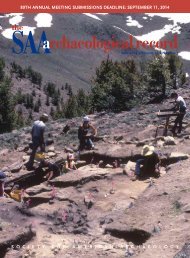SAA
SAA_Record_Nov2015
SAA_Record_Nov2015
You also want an ePaper? Increase the reach of your titles
YUMPU automatically turns print PDFs into web optimized ePapers that Google loves.
PROS AND CONS OF CONSULTING COLLECTORS<br />
When colonial cultures appropriate the heritage of those<br />
they conquered and try to integrate it into a “national heritage,”<br />
they erase the story of the original people and conflate<br />
the different histories and trajectories that each group has<br />
experienced (Watkins 2005). In the United States, the American<br />
Indian “past” is generally one of cultural loss, land theft,<br />
historic trauma, and economic repression. Is it any wonder<br />
that, when faced with the fact that the cultural wonders of<br />
the “long-before-America” people are appropriated into a<br />
“national history” that does little to acknowledge them,<br />
American Indians react so harshly? The loss of the material<br />
cultures of their ancestors only mirrors the rest of their experiences<br />
at the hands of their benevolent masters.<br />
Heritage as “Private Property”<br />
Differences in heritage management between the United<br />
States and Europe may also be attributed to differences in<br />
the origin and development of national identities. Denmark<br />
and England, for example, developed in situ, generally<br />
springing out of local population development. Of course<br />
there were conquests and influxes of outsiders, but the general<br />
cultural and governmental foundation was established<br />
long ago. The United States, however, generally developed<br />
out of a population that imposed itself on the original inhabitants,<br />
seeking to both govern and assimilate those people.<br />
Many countries in Latin America share similar histories of<br />
colonization and assimilation, and subsequent appropriation<br />
of the past of the colonized into a national heritage that<br />
essentially precludes those who created the foundation.<br />
There is no direct connection to the pre-Contact cultures of<br />
North and South America, but the United States is perhaps<br />
the most prominent country that fails to acknowledge the<br />
importance of protecting its heritage on ALL of the lands<br />
within its borders.<br />
Thus, in the United States, a view of “heritage” as “property”<br />
is not surprising given that even in countries that have a concept<br />
of “national heritage,” such objects often show up on<br />
the world market. What is important, however, is not the<br />
idea that no “national” heritage exists in the United States,<br />
but rather that the federal government has limited its protection<br />
to federal lands to the detriment of nationally significant<br />
cultural materials found on private property. Even though<br />
the government has deemed the past to be of importance to<br />
all Americans, it has failed to adequately protect heritage<br />
with that lofty goal in mind by failing to extend that concept<br />
to material found on private lands (Watkins 2003).<br />
Archaeologist-Collector Relationships<br />
Pitblado (2014) certainly argues a case for archaeologist-artifact<br />
collaboration, and I agree in the utility for a generalized<br />
understanding of the human use of an area. The knowledgeable<br />
and ethical collector may be a resource to be utilized,<br />
documenting localities that produce artifacts, having more<br />
time to search, being more knowledgeable of land ownership<br />
(and landowners) within their communities. These things<br />
are good in a “good” collector who recognizes the scientific<br />
information that can be provided, bad in a “bad” collector<br />
who competes with archaeologists for the material culture of<br />
the past.<br />
There are collectors who operate at a high level of scientific<br />
standards and who provide useful information. Unfortunately,<br />
there are also those who operate at questionable levels that<br />
have negative influence on national and archaeological heritage.<br />
It is important for the discipline to recognize this distinction<br />
of practitioners, but it is just as important that we<br />
don’t inadvertently create a growing body of people who systematically<br />
pick up artifacts from archaeological sites in their<br />
quest for information to share by failing to use every opportunity<br />
to hammer on the context issues.<br />
Legal Versus Ethical<br />
As is obvious from the previous discussion, and from the<br />
various opinions that abound when one talks about archaeologist-collector<br />
relationships, there is no single “right”<br />
answer. As Pitblado (2014:387) notes, “the ethics associated<br />
with artifact collecting are as complex and nuanced as the<br />
people doing the collecting.” So, too, are the ethics of the<br />
archaeologists who interact with the collectors. While this is<br />
a true statement, it certainly can become a straw man to justify<br />
many different actions. It is this multiplicity of nuances<br />
and variations in degrees which places the student in ethical<br />
quandaries: are collectors who collect artifacts from known<br />
sites “good” if they provide detailed contextual information,<br />
yet dig the artifacts? Are collectors “good” if they do “good”<br />
scientific excavations without a research design on sites that<br />
are not endangered by erosion or destruction? Are collectors<br />
“bad” because they create great scientific data but don’t give<br />
me access to their records?<br />
I once debated with a collector associated with a specific conference<br />
of the sort Pitblado (2014) mentioned about collector<br />
attendance at conferences (Watkins 2000). I felt no compunction<br />
about entering into that conversation as a means of<br />
explaining my position and trying to gain a better understanding<br />
of the collector’s. Most importantly, in my opinion,<br />
November 2015 • The <strong>SAA</strong> Archaeological Record<br />
15




